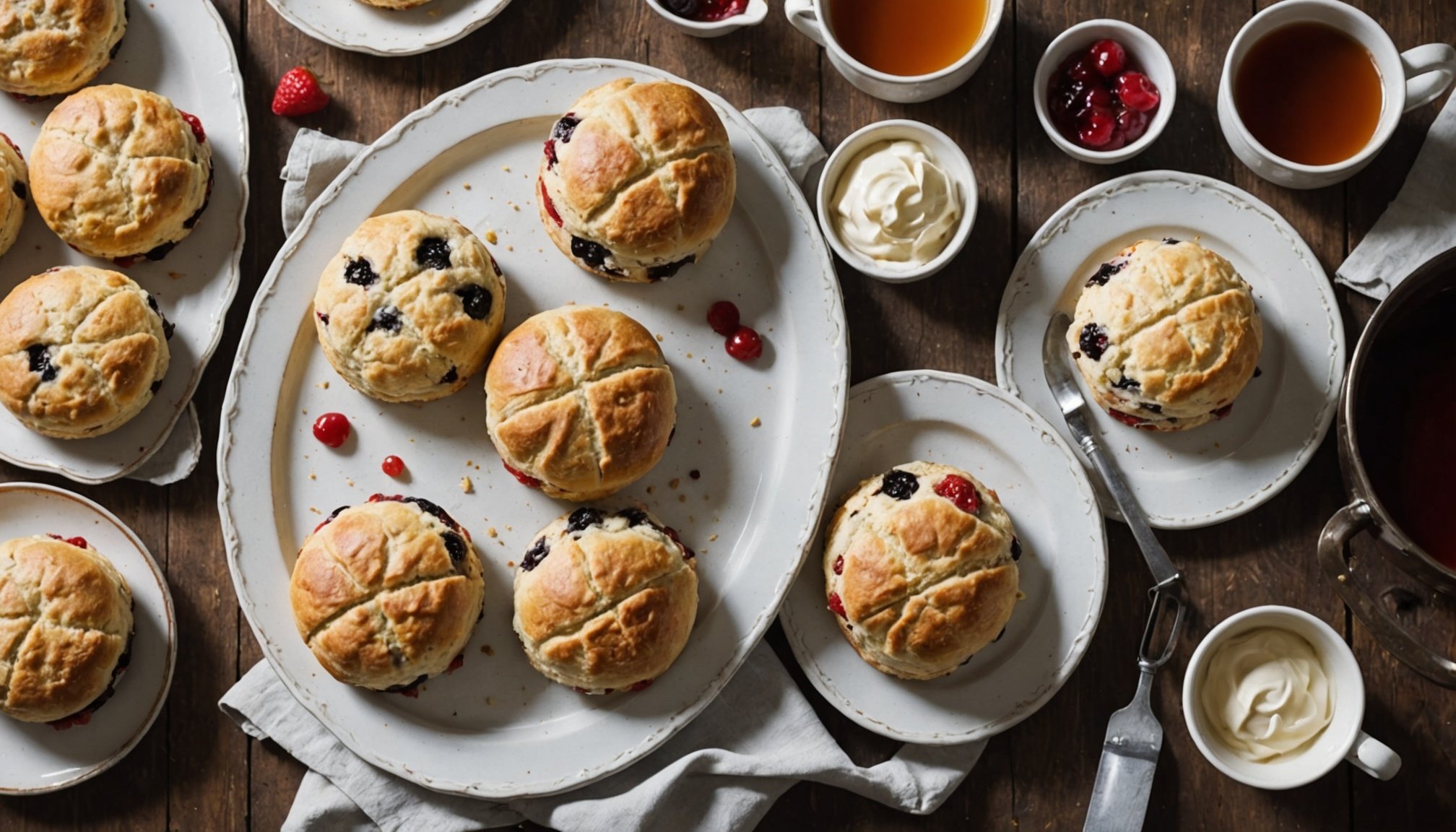Understanding Traditional British Scones
Traditional British scones hold a cherished place in British culture, historically associated with tea time. First mentioned in Scottish origins, these scones have evolved, yet their essence remains rooted in tradition. Beyond their historical significance, the key ingredients play a pivotal role. Typically, a scone recipe includes flour, butter, sugar, milk, and baking powder. Each component is chosen for its ability to create the light yet slightly crumbly texture scones are famous for.
Flour forms the backbone, while butter contributes richness and flavour. The sugar adds mild sweetness, complementing the buttery texture. Fresh milk creates moisture, making dough pliable. Baking powder acts as a leavening agent, ensuring the perfect rise. It’s essential to understand these basics before experimenting with variations.
Also read : The ultimate guide to perfect pear tart tatin: craft luxurious layers with homemade caramel magic!
Modern scone recipes deviate slightly from traditional methods, introducing new flavors and add-ins, such as fruit and chocolate. While these innovations add exciting dimensions, the classic scone remains unconquered in simplicity and taste. Knowing the scone history, enthusiasts can appreciate both traditional and modern recipes, recognising the artistry involved in perfecting these delightful treats.
Essential Ingredients for Perfect Scones
To master the art of baking traditional British scones, understanding the role of each ingredient is crucial. Central to this is the use of high-quality flour. Opting for a suitable flour type, like self-raising or all-purpose, ensures a nice, light texture. Flour’s quality directly impacts the end product, making it fundamental to achieving the desired consistency.
In the same genre : Unlock the flavor: must-have spices for crafting authentic indian curries
Butter, another core component, defines scones’ richness and crumbly nature. Variations like unsalted or salted butter influence flavour subtly. The choice between these can alter the overall taste profile, offering bakers a chance to experiment.
Importantly, baking powder acts as a vital leavening agent, creating that perfect rise we’re all after. Correctly measuring and incorporating it into your mixture brings out the ideal texture. Balancing this with the right flour and butter types is a delicate, yet rewarding, process.
Each of these quality baking ingredients plays an integral role in the making of delightful scones. By selecting and using them carefully, bakers ensure their creations rise to the occasion, maintaining the essences of both tradition and taste.
Mastering the Technique
Step-by-Step Guide on Mixing Dough
To craft perfectly fluffy scones, mastering dough mixing techniques is essential. Begin by combining dry ingredients, focusing on a gentle blend to avoid overworking. This ensures a consistent texture throughout. Incorporate the butter by rubbing it in until the mixture resembles coarse breadcrumbs.
Tips for Kneading and Shaping Dough
When kneading, handle the dough as little as possible. Over-kneading can lead to dense, tough scones. Ensure you lightly press and fold the dough—it’s all about achieving a light and airy consistency. Shaping involves gently patting the dough into a round shape before cutting with a sharp cutter for clean edges.
The Significance of Chilling Dough
Before baking, chilling the dough is crucial. This step helps solidify the butter, contributing significantly to the scones’ flakiness. A short chill, around 15-30 minutes, does wonders for texture. Cold butter ensures steam escapes during baking, forming layers that elevate scones to perfect heights.
By embracing these scone baking techniques, aspiring bakers can enhance their skills, creating delightful traditional British scones that remain true to their roots while showcasing newfound expertise in dough handling.
Achieving the Ideal Texture
Creating fluffy scones is all about the right touch, ensuring you end up with light and airy results. To assess the dough’s consistency, aim for a mixture that holds together without being sticky. Overworking the dough is a common pitfall—handle it gently to maintain delicacy. Avoid kneading too much, as this can lead to dense scones.
Techniques to perfect this include using soft, gentle movements when mixing and shaping the dough. A light hand is crucial for preserving air pockets, indispensable for the sought-after airy texture. Be mindful of your oven’s baking times and temperatures; each scone recipe may require slight adjustments. Ensure your oven is preheated to the right temperature to create the perfect rise.
Keep a close watch during baking—the timing impacts the scone’s texture significantly. Guide yourself by appearance: they should be golden on top while still soft inside. Remember, the journey to achieving the ideal scone texture is a balance between science and art; a small variation in handling can make a big difference.
Common Pitfalls in Scone Baking
Creating the perfect traditional British scone is an art. However, even experienced bakers face common scone errors. Accurately measuring ingredients is vital; even a small deviation can drastically affect the outcome. Precision ensures a well-balanced dough, crucial for achieving the right consistency.
Handling dough correctly is another challenge. Overworking leads to dense, tough scones, far from the desired fluffy result. To avoid dense scones, knead gently and briefly. This maintains air pockets, providing the sought-after light texture. Similarly, cutting scones with a sharp cutter reduces the risk of compact sides that hinder rising.
Temperature management is another key. Ensure your oven reaches the specified heat before baking. Inadequate temperatures lead to splotchy cooking, compromising texture and rise. Timing is pivotal: scones should be golden brown on top and soft inside—an indicator of optimal baking.
Troubleshooting scones begins with identifying these pitfalls. By adjusting techniques, bakers can transform errors into lessons, ultimately mastering scone baking. Remember, consistency and attention to these details can elevate the home-baking experience, creating delightful scones every time.
Creative Variations on Traditional Scones
Once you’ve mastered the basics, exploring scone variations can be a delightful venture. Incorporating popular flavor combinations like fruit or chocolate introduces exciting twists to the classic recipe. Fruit scones, using berries or dried fruit, provide natural sweetness and moisture, blending beautifully with the modest sugar content in traditional scones. Adding chocolate, such as chips or cocoa powder, elevates the indulgence factor without overwhelming the dough.
Integrating these new ingredients requires careful consideration to retain the scones’ famed texture. Unique scone recipes should maintain the balance—extra fruits or chocolate mustn’t overshadow the essential structure created by flour, butter, and baking powder. To succeed, slightly adjust the dry-to-wet ingredient ratio to accommodate for excess moisture.
Seasonal recipes offer timely twists, showcasing ingredients at peak freshness. For instance, a lemon and cranberry combination in winter or apricot and almond in summer brings seasonal vibrance to your scones. Craft seasonal scone recipes with utmost respect for the basic technique and ingredient roles, creating harmonious and inventive treats. Remember, the key is to innovate without relinquishing the classic qualities that make scones a beloved British staple.
Tips for Presentation and Serving
Scone presentation can transform a simple tea-time into an elegant affair. Plating scones with attention to detail showcases them as the highlight of any table setting. Use a clean, white platter to contrast the golden hue of the scones, sprinkling a light dusting of icing sugar or adding a few fresh berries for a colourful touch.
When it comes to serving, classic accompaniments like clotted cream and jam are timeless favourites. Clotted cream, with its rich, indulgent texture, pairs beautifully with the subtle sweetness of jam, bringing forth the scone’s buttery notes. For an authentic experience, it’s vital to let these elements shine alongside the scones.
The tradition of afternoon tea plays a significant role in the scone experience. Originating in the 19th century, this British ritual highlights the social side of scone enjoyment. Serve scones warm, resting atop a tiered cake stand, accompanied by a fine selection of teas. This practice not only accentuates the flavours but also embraces the comforting, communal aspect of scone consumption.
By mastering these aspects, bakers can enhance both the visual and sensory pleasure of serving scones.
Additional Resources for Aspiring Bakers
Embracing the artistry of scone baking invites continuous learning and refinement. Engaging with comprehensive resources enhances understanding and skill. Baking tutorials offer visual guidance, breaking down processes into manageable steps for clarity. Seeing techniques in action—like dough mixing or shaping—provides insight that text alone might miss. Visual aids such as videos and photo guides bridge the gap between theory and practice, enabling bakers to replicate techniques with confidence.
Expert advice, through recommended books and online platforms, deepens knowledge. Classic texts or contemporary guides on scone baking offer tried-and-tested wisdom, spanning from traditional British methods to modern innovations. These books serve as reliable companions in a baker’s journey of mastering scones.
Community resources, such as local baking classes or workshops, provide invaluable hands-on experience. Participating in these classes fosters direct interaction with experienced bakers who can offer tailored insights and address individual questions. It’s a fantastic opportunity for aspiring bakers to hone their skills in scone baking.
Exploring these resources empowers bakers to advance from basic to expert levels. By continually seeking knowledge and understanding baking tutorials and embracing community opportunities, the craft of making perfect scones becomes an achievable and rewarding pursuit.





